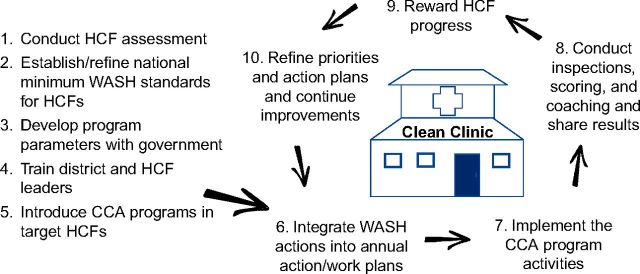Good WASH = Good Healthcare
Many governments and maternal and child health promoters have been urging pregnant women to deliver their babies at a healthcare facility rather than at home, with the intent of improving childbirth outcomes. But without water, sanitation, and hygiene (WASH), those women, their babies, and even the staff are at risk. Staff and patients require reliable water services, accessible and clean toilets, safe disposal of medical and other waste, handwashing at toilets and all points of care, and cleaning across all parts of a clinic or hospital. Effective WASH in healthcare facilities can lead to reductions in deaths, illnesses, cost savings, and reductions in antibiotic use and antimicrobial resistance.
That’s why it is shocking that, even during a pandemic, one in three healthcare facilities globally does not have adequate hand washing facilities at critical points of care, and 1.8 billion people use or work in healthcare facilities without basic water services. When there is not enough water for cleaning and hand washing, healthcare providers and patients are at increased risk of healthcare acquired infections and spreading infectious diseases. “We want people to seek healthcare services at facilities, but at the same time, we are presenting them with significant risks at facilities,” said Stephen Sara, Senior WASH Advisor at Save the Children. Save the Children is one of USAID’s partners in the Maternal and Child Survival Program. “If you can’t wash your hands, you can’t have good hygiene and you can’t clean effectively,” Sara said. “That’s when the healthcare environment becomes an infection-spreading site. And that is what we want to fix.”
Small adjustments, big improvements
It’s not enough for a clinic or hospital to have access to safe, convenient water services and clean toilets. Keeping a healthcare facility hygienic and keeping patients and staff safe also requires a holistic approach. Systems and skilled people must be in place to maintain and make repairs to water and sanitation facilities, clean regularly, and ensure all staff are washing their hands. Clinic managers need to include line items in their budgets for these activities and governments must provide funding for these budgets.
In Guatemala, as part of the Maternal and Child Survival Program, the Clean Clinic Approach used a 10-step process to empower healthcare staff to make simple, low-cost improvements that protected patients and staff from infection. It focuses on management, motivation, and accountability as key drivers to maintaining water and sanitation services, hygienic conditions, and infection prevention control. “[W]e see the infrastructure approach as necessary but temporary, unless you strengthen the capacity of staff for water management,” Sara said.
The Clean Clinic Approach was built upon previous work in Haiti, and has led to similar work in India, Ghana, Nigeria, Sierra Leone, and Uganda. The approach builds capacity of district health offices to monitor and assess infection risks, and works with ward supervisors and staff to reduce infections where the risk is greatest.

10-Step Clean Clinic Approach for WASH Quality Improvements. Abbreviations: CCA, Clean Clinic Approach; HCF, health care facility; WASH, water, sanitation and hygiene. Photo credit: Save the Children
From 2018 - 2019, the project implemented the Clean Clinic Approach in 11 healthcare facilities in Guatemala’s Western Highlands, assessing progress throughout the year. Facilities were scored across eight areas: 1) water, 2) sanitation, 3) hygiene, 4) sterilization, 5) waste management, 6) environmental cleaning, 7) administration and documentation, and 8) hot water, wastewater, and stormwater. The facilities that scored 70 points or higher received Clean Clinic certification and silver (70%–80%), gold (81%–90%), or diamond (91%–100%) status.
Before the intervention, no facilities met basic service standards for sanitation or waste management. By the end, all facilities had toilets and sinks with safe water, soap, and towels for hand-drying and better waste management systems. Every facility achieved Clean Clinic status, with eight facilities achieving gold certification and three earning diamond status. “The Clean Clinic Approach in Guatemala really demonstrates that you don’t need big infrastructure investments for new facilities. You just need to solve the system problems. If you do that, then you can make huge gains in hand washing,” said Jesse Shapiro, Senior WASH Advisor at USAID.
A water-secure world is possible
To achieve universal health coverage requires that we keep WASH at the top of global, national, and subnational agendas. The Clean Clinic Approach in Guatemala is just one example that demonstrates USAID’s commitment to finding and implementing multi-faceted solutions that improve equitable access to WASH in healthcare settings and protect access to quality essential health-care services. It highlights how close collaboration with national and local governments and staff in healthcare facilities leads to better WASH services, even without large infrastructure investments.
To learn more about ensuring quality WASH for quality healthcare, read USAID’s Technical Brief: WASH in HCFs for Quality Health Systems.
By Amy Dempsey, Communications Specialist
Related Resources
- USAID’s Vision for Health System Strengthening 2030.
- A Technical Guide to IPC Facility Program Assessment and Development of IPC Improvement Plans. USAID Medicines,Technologies, and Pharmaceuticals (MTaPS) Program. Washington, DC.
- Implementing a Continuous Quality Improvement Approach to Strengthen Infection Prevention and Control Programs at Health Facilities in MTaPS Program Countries.Washington, DC.
- WASH in Healthcare Facilities


